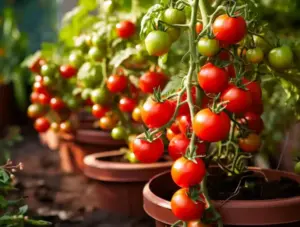Revolutionary Tomato Growing Hacks for a Bountiful Harvest
Revolutionary Tomato Growing Hacks for a Bountiful Harvest! 🍅💥💬👇
Tailored Fertilization: A Balanced Approach

Understanding the nutritional needs of tomatoes is crucial for their development. Early in their growth cycle, tomatoes benefit from nitrogen to promote foliage, which is essential for photosynthesis and overall energy. However, as the plant begins to flower and set fruit, the focus should shift towards fertilizers higher in phosphorus and potassium. This adjustment encourages fruit development over leaf growth, ensuring a more fruitful harvest.
Seed Fermentation: Prolonging Vitality
Tomato seeds are often saved for future planting, but traditional drying methods might not safeguard them against diseases or extend their shelf life significantly. Fermenting tomato seeds is a game-changer. This process not only extends the seeds’ viability up to a decade but also eliminates the gel coating, enhancing germination rates and disease resistance.
Ethylene Ripening: Salvaging the Unripe
As the growing season ends, gardeners are often left with unripe tomatoes. By harnessing the power of ethylene gas, produced naturally by fruits like apples and bananas, you can encourage these green tomatoes to ripen off the vine. Storing them together in a box can transform them into ripe, ready-to-eat fruits, minimizing waste and maximizing your yield.
Planting Diversity: Managing Abundance

To avoid the overwhelm of a simultaneous tomato glut, diversify your planting. Choose varieties with staggered maturing times or space out your planting dates. This strategic approach ensures a continuous, manageable supply of tomatoes throughout the season, rather than a sudden, unmanageable bounty.
Deep Planting: Strengthening Roots
Tomato plants benefit immensely from being planted deeply in the soil. This technique encourages the formation of additional roots along the buried stem, leading to a more robust and resilient plant. For colder climates, ensure the soil at the bottom of the hole reaches an optimal temperature before planting, or consider a horizontal planting method to achieve similar results.
Pruning Practices: Focusing Energy
As the end of the growing season approaches, topping or pruning your tomato plants can redirect their energy towards ripening existing fruits rather than producing new growth. This practice is particularly useful for encouraging the maturation of late-season tomatoes and can be a strategic move for managing plant size and harvest timing.
Cloning Success: Propagating Favorites
If you’ve discovered a tomato variety that you can’t get enough of, cloning allows you to replicate it without starting from seed. By taking healthy suckers from the plant and rooting them, you can quickly expand your crop of favored tomatoes, extending your growing season and increasing your harvest without compromising on quality.
Space Optimization: Pruning for Density
Limited garden space doesn’t have to limit your tomato variety. By pruning your plants to maintain one or two main stems, you can fit more plants into a given area. This not only allows for the cultivation of more varieties but also promotes earlier fruiting, enhancing your garden’s productivity and diversity.
Dry Farming Experimentation: Flavor Intensification

Borrowing from the practices of viticulture, dry farming tomatoes involves minimal watering, encouraging deep root growth and potentially intensifying the flavor of the fruits. This method requires specific soil conditions and climate but offers an intriguing approach to sustainable gardening and flavor enhancement.
Sunlight Management for Fruit Size
The amount of sunlight your tomato plants receive can significantly impact the size of the fruits they produce. Larger varieties, like beefsteaks, require more sunlight to develop fully compared to smaller cherry tomatoes. Tailoring sunlight exposure according to the variety can optimize fruit production and ensure the success of both large and small tomato types.







